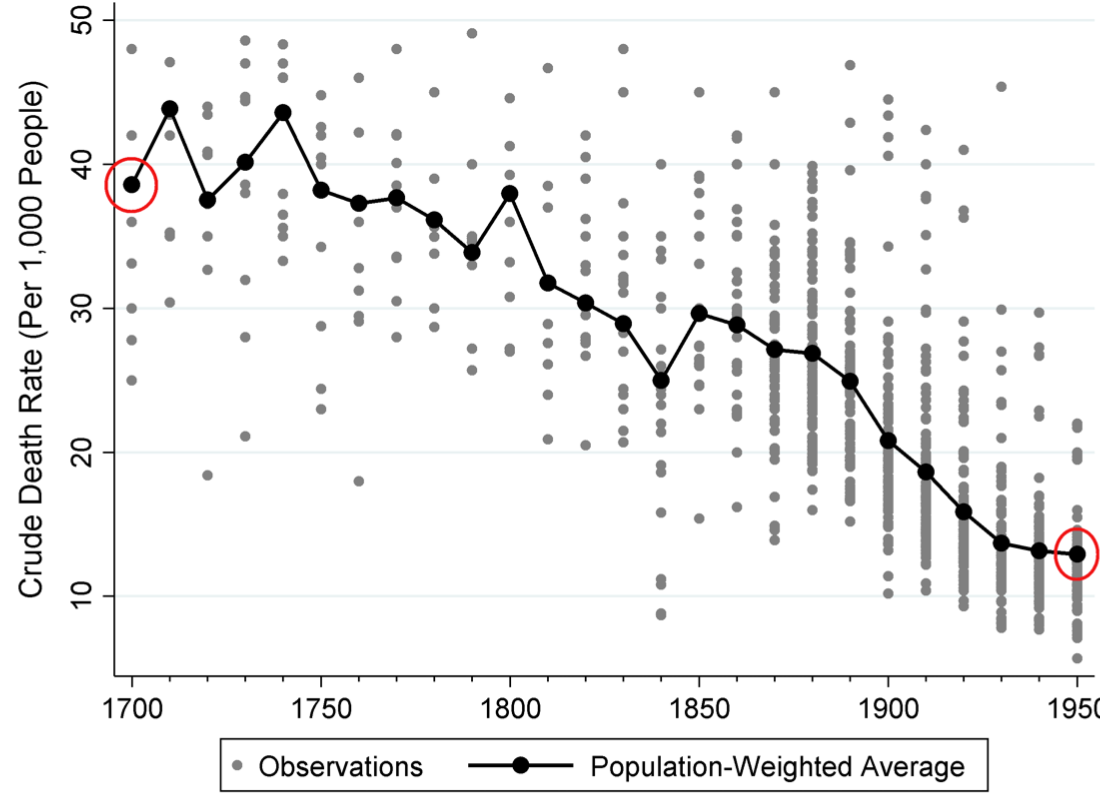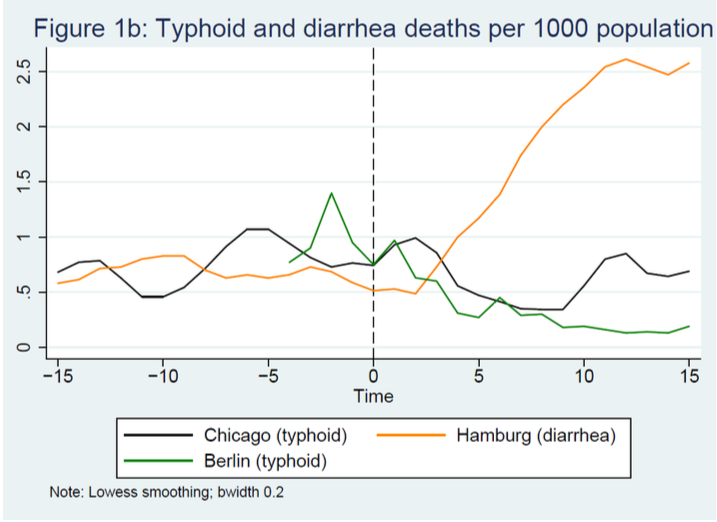
Tackling the big stink: Investing in water and sanitation systems
The question of how to finance water systems is not a new one. While drawing from lessons from the past, this post looks at the impact of investing in water systems, and the challenges funding mechanisms face.
Not too long ago, today’s metropolises, London, Paris and Berlin, were grappling with similar questions to those that many developing country cities currently face: how does one finance large investments in sewerage and water systems for cities? 19th century Europe and the US had even higher mortality rates from water borne disease, such as cholera and typhoid, than today and there was no way to direct waste water and sewage out of the city. At one point, the smell in London got so bad that parliament was not able to function, an episode referred to as “The Big Stink”. Over time, these cities all managed to retrofit a large scale sewerage system. The pursued varying means of finance including central government financing in the case of Paris, cajoled and partially illegal financing from state and central government in the case of Chicago and New York, and financing from reparations as a result of the Franco-Prussian War in the case of Berlin (Buckley 2017). In none of these cases, however, was the sewerage system self-financed.
Identifying sustainable funding mechanisms is an important consideration for developing countries today, which also have to retrofit infrastructure in the city in a situation where the urban fiscal space is even tighter than it was in the 19th Century. At the same time, the rapid pace of urbanisation is significantly increasing the demands for infrastructure. This not only includes sewers and water systems, but also roads, housing, hospitals and schools. Therefore, governments face large and complex investment decisions in terms of what to prioritise given limited resources.
Why invest in water and sanitation?
The case for water and sanitation is strong as it has direct effects on people’s health. In 2015, over 330 million people in Sub-Saharan Africa were accessing water from unsafe sources. Interventions that promote safe water provision, adequate sanitation and proper hygiene education are therefore meant to prevent a variety of illnesses spread through the transition of faecal matter. Although various strides in public health have been made, particularly with vaccines and anti-biotics, the disease burden is still concentrated amongst low income populations and increasingly amongst the urban poor. Without any investments in this area, the disease burden is only going to get worse for two reasons. Firstly, urban areas are set to grow significantly; some estimates have the urban population adding 400 million people in Sub-Saharan Africa in the next 25 years. The more people crowd into cities that lack sufficient infrastructure, the higher will be the impact of morbidity and mortality associated with water borne diseases. Secondly, if and when diseases begin to develop anti-biotic resistance, low-income residents may be less able to rely on relatively cheap medicine to make up for a lack of urban water and sanitation infrastructure.
Impact on health
The provision of the underlying infrastructure is only the first step, however. A subsequent and important consideration is understanding how to get people to use it. In particular, when it comes to water pipes, Ashraf, Glaeser and Ponzetto (2016) highlight that it is not just about providing core infrastructure, but it is also about incentivising property owners to connect to this infrastructure. Furthermore, once they are connected, it is also about ensuring a constant, uninterrupted flow of water through these pipes. Ashraf, Glaeser et al’s (2017) most recent research analyses the frequent and localised occurrence of unexpected water outages in Lusaka, Zambia. They find that these outages have numerous negative effects on health, increasing the incidence of diarrhoea, upper respiratory diseases, typhoid, fever and measles.
Impact on economic productivity
Water and sanitation systems impact not only health but also economic productivity. In the same study, Ashraf, Glaeser (2017) et al find that water outages cause adolescent girls to spend on average 10 minutes more time doing chores, due to water outages. This is time that they could feasibly be spending on studying or other productive activities. They also find a decrease in electronic money transfers due to water outages, providing further evidence for decreased economic activity.

The productivity effects of the lack of water and sanitation systems were also evident in 19th Century Europe: using data for the top 100 cities for about 1007 city years, Gindelsky and Jewab (2017) noted that there was a significant urban wage penalty as a result in higher urban mortality (figure 1). They posit the further effects of this being depressed firm growth that would impact the agglomeration effects found in urban areas and hence, overall productivity. In subsequent research of 35 developing countries, Jedwab, Christanesen and Gindelsky (2017) find however, that this urban wage penalty no longer exists today.
The role of institutions
The construction of wide-ranging sewerage systems in the 19th century not only had positive effects on productivity and on health, but on institution building as well. As Buckley (2017) highlights, the necessity of the wide-scale construction helped policy makers better understand that a piecemeal approach to addressing urban challenges was not efficient or effective. Rather large investments in urban systems require large-scale planning across a range of disciplines and actors. These governance issues are still very much a concern and challenge in Sub-Saharan African cities today.
Ashraf, Glaeser et al (2017) also note institutional considerations in the case of Zambia. They found that the water companies were more likely to respond to complaints in high income areas than in poorer areas even though some of the most pressing negative impacts of water outages are seen poorer communities. Drawing parallels again with 19th century Europe, the initial introduction of a sewerage system in Hamburg, Germany did not have the intended positive outcomes due to the fact that it neglected poorer areas (figure 1b). This lead to an outbreak of a cholera epidemic in Europe (Buckley 2017). Ashraf, Glaeser, Ponzetto (2016) also find that in Zambia, an institutional reason why water and sanitation systems struggle to be extended to poorer areas is that these areas often do not have legally enforceable property rights. This makes it difficult for the government to impose fines on them. Further research is needed to better understand the institutional setting as well as incentives of water and sanitation provision in areas much less likely to afford it.

Conclusion: complexities and considerations
Investments in urban water and sanitation systems require coordinated and complex approaches, which will not bring much, if any, revenue to the government. Furthermore, as cities continue to rapidly grow, retrofitting for these systems will become even more expensive. At the same time, research both from 19th century Europe and the US as well as the countries like Zambia, has highlighted both the health and productive benefits of a functioning water and sanitation system. Therefore, when measuring the costs and benefits the challenge is how you finance a large fixed cost system to address an issue that has wide ranging externalities. And perhaps, more importantly, given that many of these outcomes are on mortality and overall human capital, how do governments put a figure to this when evaluating their investments?
References
Ashraf, N., Glaeser, E. and Ponzetto, G. (2016) “Infrastructure, Incentives and Institutions” American Economic Review Vol 106, No 5 pp 77-82
Ashraf, N., Glaeser, E., Holland, A. and Steinberg, B. M. (2017) “Water, Health and Wealth” NBER Working Paper No 23807
Buckley, R. (September 2017) Financing Sewers in the 19th Century Largest Cities: A Prequel for African Cities? Presentation at the World Bank/IGC/GWU 4th Urbanisation and Poverty Reduction Conference.
Gindelsky, M. and Jedwab, R. (Forthcoming). “Killer Cities vs. Killer System of Cities: Historical Evidence from 1690 to 1950” accessed from Jedwab, R. (2017) Urban Sanitation in the Urban Development Agenda. Presentation at the World Bank/IGC/GWU 4th Urbanisation and Poverty Reduction Conference.
Jedwab, R., L. Christiaensen and M. Gindelsky (2015). “Demography, Urbanization and Development: Rural Push, Urban Pull and... Urban Push?” Journal of Urban Economics (forthcoming)

